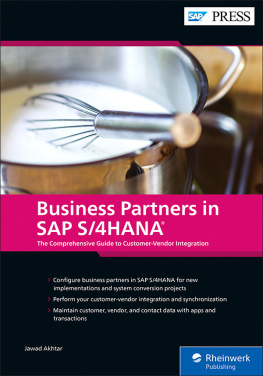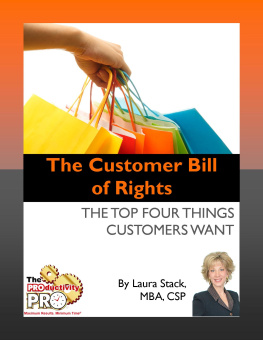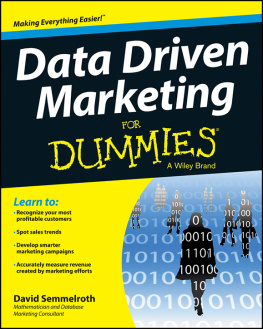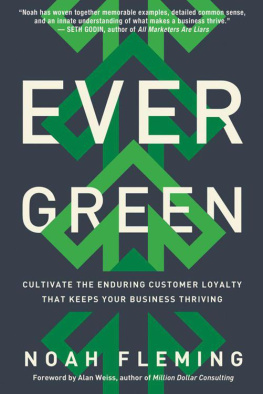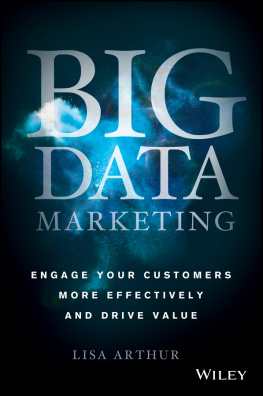THE INTENTION ECONOMY
When Customers Take Charge
DOC SEARLS
HARVARD BUSINESS REVIEW PRESS
Boston, Massachusetts
Copyright 2012 Doc Searls
All rights reserved
Printed in the United States of America
10 9 8 7 6 5 4 3 2 1
No part of this publication may be reproduced, stored in or introduced into a retrieval system, or transmitted, in any form, or by any means (electronic, mechanical, photocopying, recording, or otherwise), without the prior permission of the publisher. Requests for permission should be directed to , or mailed to Permissions, Harvard Business School Publishing, 60 Harvard Way, Boston, Massachusetts 02163.
Library of Congress Cataloging-in-Publication Data
Searls, Doc.
The intention economy : when customers take charge / Doc Searls.
p. cm.
Includes bibliographical references.
ISBN 978-1-4221-5852-4 (alk. paper)
1. Customer relations. 2. Customer service. 3. Consumers preferences. 4. New products. I. Title.
HF5415.5.S448 2012
658.8342--dc23
2011053277
For Joyce
As for the future, your task is not to foresee it, but to enable it.
Antoine de Saint-Exupry
PROLOGUE
Paying Attention to Intention
In matters of style, swim with the current. In matters of principle, stand like a rock.
Thomas Jefferson
Words may show a mans wit but actions his meaning.
Benjamin Franklin
The Insight
Work on this book started in March 2006, when I was covering OReillys Emerging Technologies (eTech) conference in San Diego for Linux Journal. The conference theme was The Attention Economy. Sitting in the audience taking notes, I thought, Why build an economy around attention, when intention is where the money comes from? So I wrote an article, on the spot, titled, The Intention Economy. An excerpt:
The Intention Economy grows around buyers, not sellers. It leverages the simple fact that buyers are the first source of money, and that they come ready-made. You dont need advertising to make them
The Intention Economy is built around truly open markets, not a collection of silos. In the Intention Economy, customers dont have to fly from silo to silo, like a bees from flower to flower, collecting deal info (and unavoidable hype) like so much pollen. In The Intention Economy, the buyer notifies the market of the intent to buy, and sellers compete for the buyers purchase. Simple as that
The Intention Economy is about buyers finding sellers, not sellers finding (or capturing) buyers.
In The Intention Economy, a car rental customer should be able to say to the car rental market, Ill be skiing in Park City from March 2025. I want to rent a 4-wheel drive SUV. I belong to Avis Wizard, Budget FastBreak and Hertz One Club. I dont want to pay up front for gas or get any insurance. What can any of you companies do for me?and have the sellers compete for the buyers business.
Positive buzz followed, but development didnt, and thats what the Intention Economy needed. So, several months later, when I was given a fellowship at Harvard Universitys Berkman Center for Internet & Society, I decided to launch a development project toward making the Intention Economy happen. We called it ProjectVRM.
VRM stood for vendor relationship managementthe customer-side counterpart of CRM, or customer relationship management, a business that appears to most of us in the form of junk mail and call centers. ProjectVRMs goal was to cause development of tools that would make individuals both independent of vendors and better able to engage with them. In other words, to fix a broken system from the customer side by developing a new system complementary to existing businesses and built on the natural independence and agency of human beings.
Behind ProjectVRM was a thesis:
Free customers are more valuable than captive ones.
And, as a corollary,
Free markets require free customers.
Since CRM was already a multibillion-dollar business category, ProjectVRM was a highly ambitious undertaking. But I was neither alone nor early. In the United Kingdom, Iain Henderson, Alan Mitchell, and others had already started the Buyer Centric Commerce Forum and were doing work on what they called personal data storesan essential VRM tool. Adriana Lukas, also in the U.K., had similar goals for both her consultancy and her blogging company, and was encouraging development work as well. The digital identity development community had also been working on some of the same problems, encouraged by the twice-yearly Internet Identity Workshops (IIWs), which Kaliya Hamilin, Phil Windley, and I started in 2005.
At Berkman, ProjectVRM consisted of myself, a mailing list, a blog, a wiki, and gatherings in the form of meetings and workshops. It still does. Out in the world, however, it has grown to consist of dozens of development efforts and hundreds of individuals, all working in their own ways to create tools that liberate customers and build the Intention Economy. This book is a progress report on that work and the evolving ideas behind it.
The Book
I hadnt planned to write this book before we had lots of working code, but two events in early 2009 changed my mind. The first was a breakfast in Toronto with my friend Rick Segal, who was then a venture capitalist there. Rick told me, in a way that could hardly be more emphatic if he had slammed me into a wall, You have to write a book! You already have a title! Its The Intention Economy! Stop screwing around! Go write it! The other was a talk I gave by the same title a few weeks later at the Berkman Center. Among those at the talk was Jeff Kehoe of Harvard Business Review Press. Jeff came up to me afterward and asked if I had considered making my talk into a book. With Ricks command still ringing in my ears, I said yes. The result is now in your hands.
Most VRM tools today are either early in development or just starting to be adopted. Many of the ideas and assumptions about VRM and the Intention Economy are also far from proven and easy to dismiss in proofs absence. We are at the early edge of the technology adoption cycle. Author Geoffrey Moores famous chasm between innovators and early adopters is still ahead of us.
So why would both Rick and Jeff want me to write a book about something that hasnt happened yet and probably will not start to happen for another several years? Two reasons: reality and promise. In reality, e-commercea huge forward leap on the economys supply sidehad already happened. But it was only the first shoe to drop. The promise was a forward leap on the demand side, by individual customers. That shoe is VRM. We dont know where it will drop first, but do we know the foot wearing it will be the customers. The Intention Economy will then step forward with both shoes, on both feet: supply on one side and demand on the other. No more hopping along on the supply side alone.
Because we are dealing with the future here, much of what you read in this book is speculative. In fact, I am willfully practicing what Nassim Nicholas Taleb (in The Black Swan) calls epistemic arrogance. He says this bears a double effect: we overestimate what we know, and underestimate uncertainty, by compressing the range of uncertain states (i.e., by reducing the space of the unknown). But I am not just making guesses here. I am also looking for effects, and I have influence over the causes of those effects. So do many others in the VRM movement, some far better equipped than I. Those intentions add up. After that, they multiply.
I have also seen this kind of intention work beforein particular with free software, open source, and Linux, all three of which Ive been covering since the mid-nineties for Linux Journal


